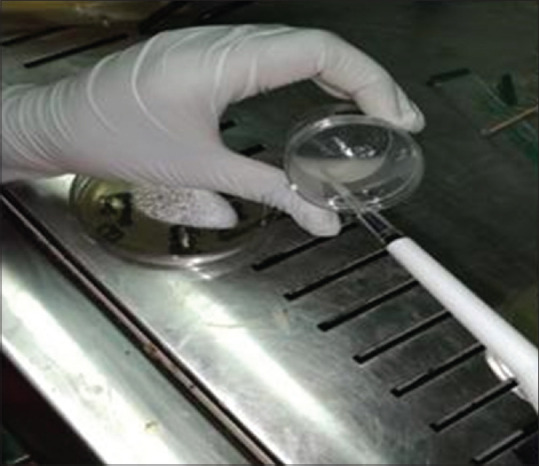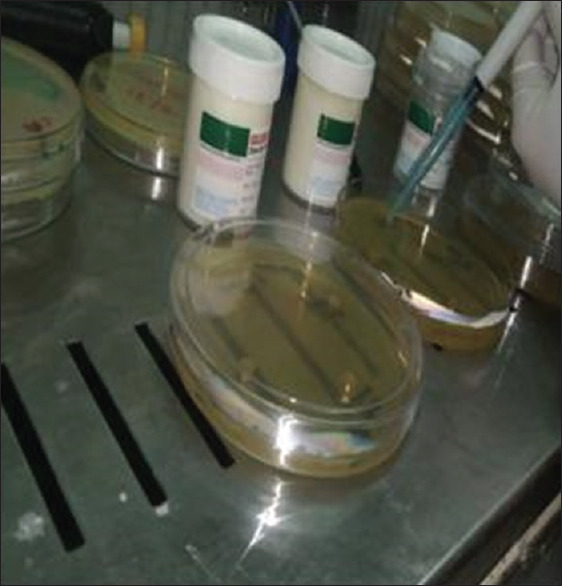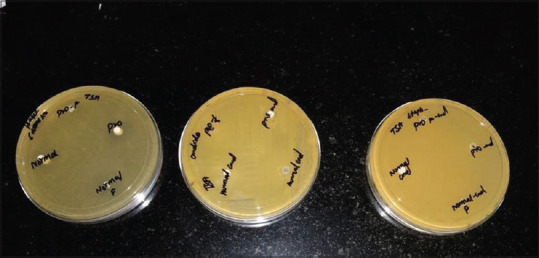Abstract
Major oral deformities fall under dental caries and periodontal diseases hence active prevention of these two diseases can contribute to good oral health and preserves oral hygiene. Streptococcus mutans, Staphylococcus aureus, Lactobacillus, Candida, and anaerobic organisms are the organisms responsible for causing oral cavity-related deformities. Probiotics which is the useful and nonpathogenic bacteria are added to food products which tend to be advantageous to human health. A wide range of studies indicates that these probiotics are useful against oral tissues. Hence, the primary goal of the study aims to determine the antibacterial potential of probiotic curd against pathogens causing various oral diseases and deformities. A laboratory-oriented in vitro microbiological study design was framed to detect the antimicrobial potential of the probiotic curd. Subgingival calculus specimens were collected and anaerobic organisms were isolated in thioglycollate broth. Lawn cultures were subjected to the surface of brain heart infusion agar and 100 μl of probiotic curd, normal curd, and filtrate were taken in a micropipette and inoculated over the specific wells. The culture plates were incubated anaerobically at 37°C for 24 h. The culture plates were monitored for the zone of inhibition to assess the antibacterial activity against the test pathogens. The results showed that there was no antibacterial activity against the anaerobic bacteria cultivated from subgingival calculus. However, further validation must be done on the same with purified components from the probiotic curd. Probiotic curd is normally considered a vital immune-boosting nutritional supplement. However, the antibacterial activity must be evaluated with care with the purified filtrates of the curd to substantiate its exact role against dental pathogens.
Keywords: Antibacterial activity, Candida, Lactobacillus, probiotic curd, Staphylococcus aureus, Streptococcus mutans
INTRODUCTION
Probiotics are useful microorganisms, these are live and aid in good for human beings which when consumed in adequate amounts.[1] These useful microorganisms have a destructive effect on the pathogenic microorganism present in the human body.[2] The growth of one microorganism by secretion from another organism is the concept behind probiotics.[3] An antagonist environment is created by the probiotics to the pathogens in substrates by releasing compounds such as bacteriocins, lysozymes, protease, and hydrogen peroxide which have the ability of inhibition.[4,5] The released inhibitory compounds released compete for adhesion sites and release essential nutrients and further improve the immune response of the host.[6] The common strains present in the probiotics were the Lactobacillus and Bifidobacterium species.[7] Bacterial strains that have been tested for probiotic actions in the oral cavity include Lactobacillus species (Lactobacillus acidophilus, Lactobacillus rhamnosus GG, Lactobacillus gassers, Lactobacillus reuter, and Lactobacillus paracasei), Bifidobacterium species (Bifidobacterium bifidum, Bifidobacterium longum, Bifidobacterium infantis, and Bifidobacterium animalis strain), Streptococcus salivarius, and Weissella cibaria.[8] The useful vehicles for probiotic bacteria were fermented dairy foods such as curd and yogurt.[9] Since curd and ice creams are universally accepted and liked they can be used as an alternative to manage dental disorders.[10] Providing nutrition and control of a wide range of diseases are the beneficiary effects of probiotics.[11] These foods can be mentioned as “natural probiotics” which are rich in protein, calcium, and Vitamin B.[12] It facilitates direct consumption of live bacteria and increases the number of beneficial microflora in the intestinal tract.[13] In oral health, probiotic curd represents a major breakthrough by utilizing the natural beneficial bacteria commonly found in the healthy oral cavity to provide a natural defense against those bacteria thought to be harmful to dentition and periodontal tissues.[14]
Oral cavity harbors present with an array of bacterial species and are a complex ecosystem. The equilibrium of the microbes in the oral cavity can easily be destroyed, leading to an increase in the accumulation of pathogenic organisms which can pave the way to various oral health problems.[15] Dental caries or tooth decay is a common disease among oral diseases.[16] As dental caries is multifactorial in causation, the pH is also a factor responsible due to the acidic oral environment.[17] The major cause of dental caries is microorganisms. Streptococcus mutans and Staphylococcus aureus are the key bacteria responsible for the development of dental caries. The progression of dental caries was by the Lactobacillus bacteria.[18] Periodontitis is another most common oral disease, which is caused by periodontal pathogens.[19] Anaerobic organisms are most commonly responsible for periodontal disorders. The other cause of periodontitis is also due to systemic illness. Replacement therapy is an alternative and a promising way to combat infections using harmless bacteria to displace pathogenic microorganisms with probiotic bacteria.[20] The use of probiotics is successful in treating gastrointestinal disorders and also to bring down the cariogenic biofilm in various studies. Cheese, curd, yogurt, lozenges, tablets, mouth rinses, and capsules are various means by which probiotics can be administered for oral health purposes.[21] The dependence of beneficiary bacteria on the food makes possible measures to restore a healthy microbiome. Thus, it is important to experiment on how probiotic curd is useful against oral and periodontal pathogens.
Hence, the main goal of this study was to detect the antibacterial potential of probiotic curd in pathogens causing dental caries and periodontitis. As probiotic curd contains Lactobacillus bacteria it may be used to prevent the action of harmful bacteria causing dental caries and periodontitis. Previous studies were conducted with probiotic lozenges and tablets but this study aims to detect the antibacterial property in food like curd which people readily consume. The study first starts to isolate the anaerobic organisms from the subgingival calculus; to assess the antibacterial property of probiotic curd on S. mutans, S. aureus, Lactobacillus, Candida, and anaerobic organisms; to assess the antibacterial property of normal curd on S. mutans, S. aureus, Lactobacillus, Candida, and anaerobic organisms; to compare the antibacterial property of probiotic curd and normal curd on S. mutans, S. aureus, Lactobacillus, Candida, and anaerobic organisms.
MATERIALS AND METHODS
The present study employed a laboratory in vitro microbiological study design and the study was conducted in the microbiology laboratory. Cultures of S. mutans, S. aureus, and Lactobacillus were obtained from the department of microbiology. Cultures of anaerobic microorganisms were obtained from the subgingival calculus specimens. The subgingival calculus specimens were inoculated in thioglycollate broth and were incubated anaerobically at 37°C for 24 h before the assay.
For the antibacterial bioassay, the lawn culture of the test organisms was subjected to the brain heart infusion agar. About 100 μl of probiotic curd was taken in a micropipette and was added into the specific wells cut on the lawn culture of the aerobic and anaerobic microorganisms [Figure 1]. The filtrate of probiotic curd and normal curd was also added to the specific wells [Figure 2]. The inoculated culture media was kept in the incubator for 24 h/37°C. Plates were incubated both aerobically and anaerobically based on the test pathogens. After incubation, the plates were observed for the zone of inhibition toward the antibacterial activity against the dental pathogens.
Figure 1.

About 100 μl of probiotic curd is taken in a micropipette
Figure 2.

The probiotic curd is inoculated into the culture media
RESULTS
The results showed that the probiotic curd and normal curd had no antibacterial activity against dental caries and periodontal pathogens. Zone of inhibition was not observed as there was no antibacterial activity against the microorganisms [Figure 3].
Figure 3.

The culture plate shows no antibacterial activity against the test pathogens
DISCUSSION
The present study stated that there was no antibacterial activity of probiotic curd among the aerobic and anaerobic organisms tested in the study. As S. mutans, S. aureus, and Candida played an important role in the development of dental caries and oral infections and anaerobic organisms responsible for periodontal conditions, this study was carried out to figure out the antibacterial activity of probiotic curd over these microorganisms. Previous studies were conducted with the probiotics “neoforma” which is a tablet form and this was tested against dental caries and periodontal pathogens and it had a significant effect on these organisms.[22] This study revealed that the growth of indigenous bacteria is influenced by the colonization of probiotic microbes.
Another study proved that L. acidophilus produces an acidogenic environment and it reduces Vitamin K production which acts as a common growth factor for many microbes.[23] In another study, lactic acid bacteria were isolated from barley, traditional dried meat, and fermented olives and these probiotic bacteria were resistant to the gastrointestinal tract, adherence to hydrocarbons, and coaggregation activity as well as susceptibility to some antibiotics. Moreover, these strains inhibited planktonic bacteria and biofilm formation hence suitable for the treatment of dental caries.[24] Probiotic strains Lactobacillus salivarius, L. rhamnosus, L. paracasei, and Bifidobacterium have greater potency for use in the development of functional foods to improve oral health.[25]
The limitations of this study include that pure strains of microorganisms are not taken to appreciate the antibacterial efficacy. Patient's strain may vary in proportion and causal factors and hence would not be able to fetch the results. Future scope of the study claims to be more appropriate usage of bacterial strains and the curd before usage needs to be analyzed for its composition and then inoculated with the pure bacterial strains which can lead to better results.
CONCLUSION
Probiotic curd is usually considered a vital immune-boosting nutritional supplement and has various medicinal effects. However, the antibacterial activity must be evaluated properly with the purified filtrates of the curd to substantiate its exact role against dental pathogens.
Financial support and sponsorship
The present project is supported/funded/sponsored by:
Saveetha Institute of Medical and Technical Sciences
Saveetha Dental College and Hospitals
Saveetha University.
Conflicts of interest
There are no conflicts of interest.
Acknowledgement
We thank Saveetha Dental College and Hospitals for providing us the support to conduct the study.
REFERENCES
- 1.Setta MC, Matemu A, Mbega ER. Potential of probiotics from fermented cereal-based beverages in improving health of poor people in Africa. J Food Sci Technol. 2020;57:3935–46. doi: 10.1007/s13197-020-04432-3. [DOI] [PMC free article] [PubMed] [Google Scholar]
- 2.Muñoz-Atienza E, Araújo C, Magadán S, Hernández PE, Herranz C, Santos Y, et al. In vitro and in vivo evaluation of lactic acid bacteria of aquatic origin as probiotics for turbot (Scophthalmus maximus L.) farming. Fish Shellfish Immunol. 2014;41:570–80. doi: 10.1016/j.fsi.2014.10.007. [DOI] [PubMed] [Google Scholar]
- 3.McLoughlin IJ, Wright EM, Tagg JR, Jain R, Hale JD. Skin microbiome-the next frontier for probiotic intervention. Probiotics Antimicrob Proteins. 2022;14:630–47. doi: 10.1007/s12602-021-09824-1. [DOI] [PubMed] [Google Scholar]
- 4.Peng M, Tabashsum Z, Anderson M, Truong A, Houser AK, Padilla J, et al. Effectiveness of probiotics, prebiotics, and prebiotic-like components in common functional foods. Compr Rev Food Sci Food Saf. 2020;19:1908–33. doi: 10.1111/1541-4337.12565. [DOI] [PubMed] [Google Scholar]
- 5.Yap PC, MatRahim NA, AbuBakar S, Lee HY. Antilisterial potential of lactic acid bacteria in eliminating listeria monocytogenes in host and ready-to-eat food application. Microbiol Res. 2021;12:234–57. [Google Scholar]
- 6.Pickard JM, Zeng MY, Caruso R, Núñez G. Gut microbiota: Role in pathogen colonization, immune responses, and inflammatory disease. Immunol Rev. 2017;279:70–89. doi: 10.1111/imr.12567. [DOI] [PMC free article] [PubMed] [Google Scholar]
- 7.Redondo-Useros N, Gheorghe A, Díaz-Prieto LE, Villavisencio B, Marcos A, Nova E. Associations of Probiotic Fermented Milk (PFM) and yogurt consumption with Bifidobacterium and Lactobacillus components of the gut microbiota in healthy adults. Nutrients. 2019;11:651. doi: 10.3390/nu11030651. [DOI] [PMC free article] [PubMed] [Google Scholar]
- 8.Bernardeau M, Guguen M, Vernoux JP. Beneficial lactobacilli in food and feed: Long-term use, biodiversity and proposals for specific and realistic safety assessments. FEMS Microbiol Rev. 2006;30:487–513. doi: 10.1111/j.1574-6976.2006.00020.x. [DOI] [PubMed] [Google Scholar]
- 9.Parmjit S. Fermented dairy products: Starter cultures and potential nutritional benefits. Food Nutr Sci. 2011;8:101–7. [Google Scholar]
- 10.Evivie SE, Huo GC, Igene JO, Bian X. Some current applications, limitations and future perspectives of lactic acid bacteria as probiotics. Food Nutr Res. 2017;61:1318034. doi: 10.1080/16546628.2017.1318034. [DOI] [PMC free article] [PubMed] [Google Scholar]
- 11.Otles S, Cagindi O. Kefir: A probiotic dairy-composition, nutritional and therapeutic aspects. Pak J Nutr. 2003;2:54–9. [Google Scholar]
- 12.Rodrigues FJ, Cedran MF, Bicas JL, Sato HH. Encapsulated probiotic cells: Relevant techniques, natural sources as encapsulating materials and food applications – A narrative review. Food Res Int. 2020;137:109682. doi: 10.1016/j.foodres.2020.109682. [DOI] [PubMed] [Google Scholar]
- 13.O’Toole PW, Cooney JC. Probiotic bacteria influence the composition and function of the intestinal microbiota. Interdiscip Perspect Infect Dis 2008. 2008:175285. doi: 10.1155/2008/175285. [DOI] [PMC free article] [PubMed] [Google Scholar]
- 14.Gupta G. Probiotics and periodontal health. J Med Life. 2011;4:387–94. [PMC free article] [PubMed] [Google Scholar]
- 15.Kilian M, Chapple IL, Hannig M, Marsh PD, Meuric V, Pedersen AM, et al. The oral microbiome – An update for oral healthcare professionals. Br Dent J. 2016;221:657–66. doi: 10.1038/sj.bdj.2016.865. [DOI] [PubMed] [Google Scholar]
- 16.Selwitz RH, Ismail AI, Pitts NB. Dental caries. Lancet. 2007;369:51–9. doi: 10.1016/S0140-6736(07)60031-2. [DOI] [PubMed] [Google Scholar]
- 17.Veiga N, Aires D, Douglas F. Dental caries: A review. J Dent Oral Health. 2016;3:2. [Google Scholar]
- 18.Ahirwar SS, Gupta MK, Snehi SK. Dental caries and Lactobacillus: Role and ecology in the oral cavity. Int J Pharm Sci Res. 2019;10:4818–29. [Google Scholar]
- 19.Scapoli L, Girardi A, Palmieri A, Martinelli M, Cura F, Lauritano D, et al. Quantitative analysis of periodontal pathogens in periodontitis and gingivitis. J Biol Regul Homeost Agents. 2015;29:101–10. [PubMed] [Google Scholar]
- 20.Caglar E, Kargul B, Tanboga I. Bacteriotherapy and probiotics’ role on oral health. Oral Dis. 2005;11:131–7. doi: 10.1111/j.1601-0825.2005.01109.x. [DOI] [PubMed] [Google Scholar]
- 21.Deogade SC. Probiotics: Contributions to oral and dental health. Oral Health Dent Manage. 2015;14:345–7. [Google Scholar]
- 22.Routh S, Pai M, Rajesh G, Shenoy R, Sarit S. Effect of probiotics on dental caries and periodontal pathogens: An in vitro study. J Orofac Sci. 2019;11:49. [Google Scholar]
- 23.Hojo K, Nagaoka S, Murata S, Taketomo N, Ohshima T, Maeda N. Reduction of vitamin K concentration by salivary Bifidobacterium strains and their possible nutritional competition with Porphyromonas gingivalis. J Appl Microbiol. 2007;103:1969–74. doi: 10.1111/j.1365-2672.2007.03436.x. [DOI] [PubMed] [Google Scholar]
- 24.Ben Taheur F, Kouidhi B, Fdhila K, Elabed H, Ben Slama R, Mahdouani K, et al. Anti-bacterial and anti-biofilm activity of probiotic bacteria against oral pathogens. Microb Pathog. 2016;97:213–20. doi: 10.1016/j.micpath.2016.06.018. [DOI] [PubMed] [Google Scholar]
- 25.Chen YT, Hsieh PS, Ho HH, Hsieh SH, Kuo YW, Yang SF, et al. Antibacterial activity of viable and heat-killed probiotic strains against oral pathogens. Lett Appl Microbiol. 2020;70:310–7. doi: 10.1111/lam.13275. [DOI] [PubMed] [Google Scholar]


